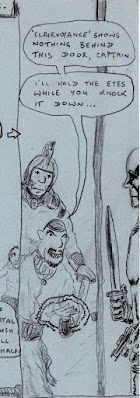It’s the time of year for me to weigh in on a claim that’s causing controversy – not to deny that the claim if true would be outrageous, but to say that I remain unconvinced that it is true. And, in line with recent tradition, the outrage again involves a professor.
This time round it’s the turn of The X-Men, first published by Marvel in July 1963, though with a cover date of September because comics. The Doom Patrol debuted in the June issue (that is, April) of My Greatest Adventure, published by Marvel’s rival DC. The bone of contention is whether Stan Lee was influenced by (ie swiped from) Arnold Drake, the writer of Doom Patrol, in putting Professor Charles Xavier in a wheelchair like the Doom Patrol’s leader.
Drake shrugged it off for years as a coincidence, but after brooding on it for forty years he became convinced it was dirty pool on Stan’s part:
"I didn’t believe so in the beginning because the lead time was so short. Over the years I learned that an awful lot of writers and artists were working surreptitiously between [Marvel and DC]. Therefore from when I first brought the idea into [the DC editor’s] office, it would’ve been easy for someone to walk over and hear that this guy Drake is working on a story about a bunch of reluctant superheroes who are led by a man in a wheelchair. So over the years I began to feel that Stan had more lead time than I realized. He may well have had four, five or even six months."
Now, I’ll put my hand up to being a fan of Marvel from way back. I grew up on those stories. So you might want to take what I have to say with that in mind, but – was Drake completely nuts? First of all, Stan Lee was having to get out more than ten books a month, and he was doing almost all the writing single-handed. Sure, he had “the Marvel method” to help (plot first, then art, then write the script) but even so it’s unlikely he had much time to look through DC’s output, at that time upwards of thirty books a month. And even if Stan had been told about Doom Patrol in January 1963, he wouldn’t have had long to single out that one idea and work it into the new book he was planning with Jack Kirby.
OK, it is just possible an artist came across from DC (it was a 13 minute walk) and mentioned that DC was doing a try-out book with a super-team whose mentor was in a wheelchair. But was that really the standout detail worth swiping? Far more likely that Stan got the inspiration for Professor X from any number of brainy invalid scientists in 1950s sci-fi movies. And in any case there’s a strong story reason for Professor X being in a wheelchair. Stan loved irony, and this character is all about the power of the mind. He’s Nero Wolfe turned up to 11.
In the same year as the quote above, Drake also said:
"Stan Lee and I were working in the same vineyards, and if you do enough of that stuff, sooner or later, you will kind of look like you are imitating each other."
Well, that change of heart is interesting. Maybe Drake had taken a step back to think about where his own ideas came from. If there was any creative borrowing going on, more likely it was in the other direction. Why was Drake creating the Doom Patrol in the first place? Because he understood the appeal of the Fantastic Four. The FF’s first issue was November 1961 – only, you know the score, that means September, so it had been running for thirteen issues by the time Drake sat down and scratched his head about what could be done to counter this new and coming force in comics.
Drake saw that the FF frequently squabbled. And they got their powers from an accident – not mutants like the X-Men, notice. And the coolest members of the team were sort of freaks, the Thing especially. So it’s not much of a stretch (I’m not planning these puns, honest) to think of Robotman as the Thing, Negative Man as the Torch, Elasti-Girl (wait, what?) as Susan Storm and the Chief as Reed.
By 2000, Drake had convinced himself he originated all this:
“That was the thing that made Doom Patrol different, these people hated being superheroes. And they were a little bit self-pitying, just a little bit, and the chief was constantly telling them, ‘Stop crying in your beer.’ That made them something that wasn't around at the time.”
It wasn't around at the time? Really? What about Peter Parker? Ben Grimm? Bruce Banner? Tony Stark? So it’s a little bit rich that a few years later Drake was saying of Stan Lee, ‘He’d take credit for the King James Bible.’
All that said, it’s interesting that these days it’s hard to make a convincing movie about the Fantastic Four, and yet there were four seasons of a Doom Patrol TV show. I didn’t stick with it even for four episodes myself, but it actually feels more modern than the FF -- who were, after all, Stan Lee’s first attempt at making superheroes real and relatable and flawed. As the prototype, perhaps it’s not surprising that the FF have dated – and they were my own least favourite Marvel comic back in the Silver Age, their adventures being too cosmic and out there to appeal alongside the convincing contemporary lives of Tony Stark, Peter Parker, Matt Murdock, et al.
If you're interested in the full fascinating story of how Marvel overtook DC and revolutionized comic book storytelling, try Reed Tucker's book Slugfest and/or Adrian Mackinder's Stan Lee: How Marvel Changed The World.













.jpg)



.jpg)



